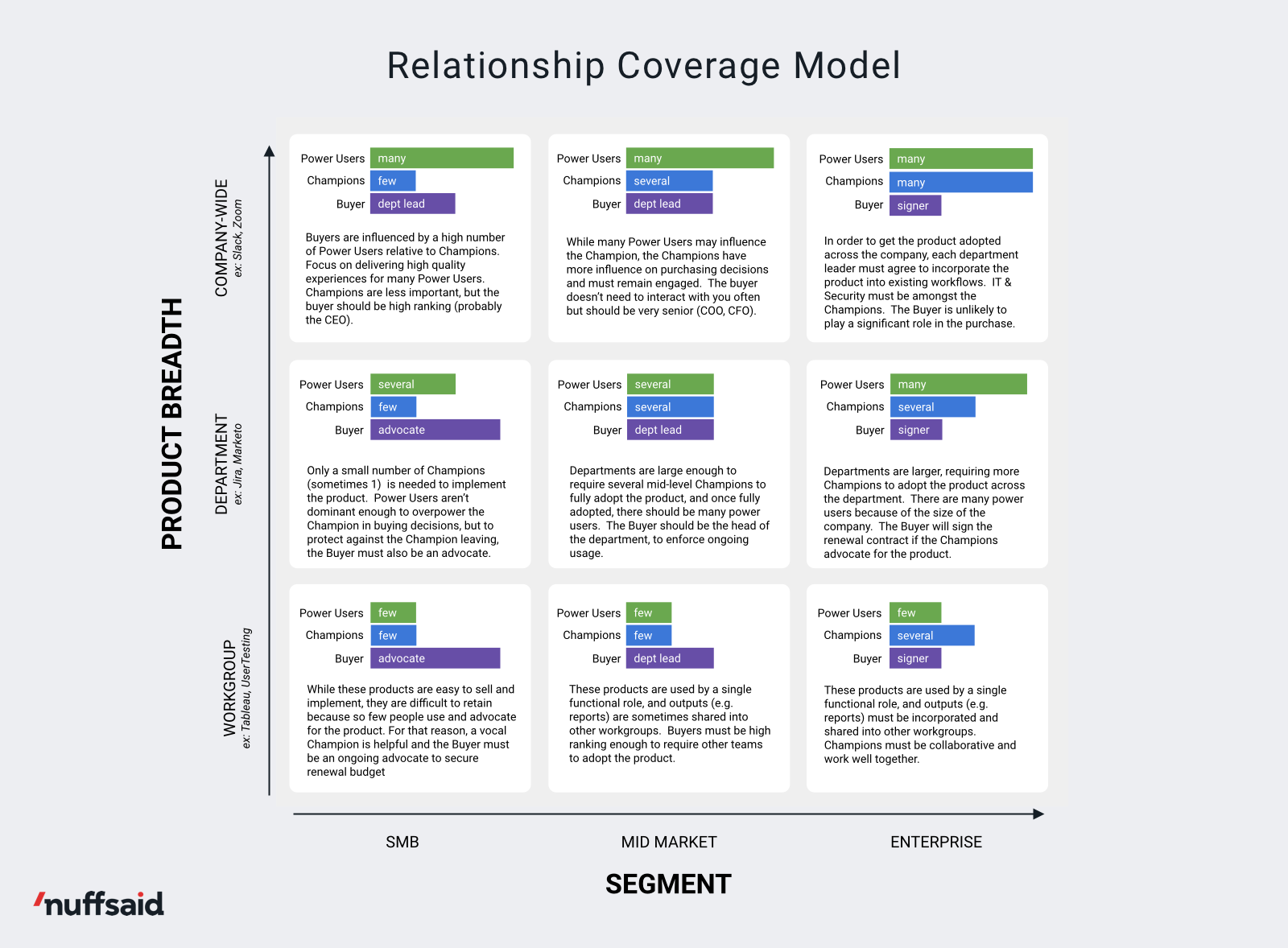An excerpt from Face it, your champion strategy is weak. Use this scorecard to get it right.
Written in collaboration with Kristina Valkanoff, Ziv Peled, Kristi Faltorusso, David Ginsburg, Emilia D'Anzica, Jeff Breunsbach, and Jay Nathan.
There are three steps to creating a relationship coverage strategy: 1. Define the roles CSMs need to build within each account, 2. Understand and track the relationship strength needed with each role, and then 3. Create a coverage plan that’s specific to the product you’re selling and the segments you’re selling into.
Here, we’ll cover Part 3: Creating a coverage plan.
When we spoke to companies about their champion coverage strategy, we heard consistent problem trends:
- The influence that Power Users have on Champions is undervalued
- The number of Champions required is insufficient to reduce risk
- The named Champion in the sales cycle isn’t acting like a Champion post-sale
- Unclear definitions of user types (Influencers, Important Contacts, Advocates, etc) leads to poor/incomplete tracking
The model below addresses these problems with verified definitions and strategy that can be applied to any business to reduce champion risk.
For example, if a company-wide product (Slack, Gmail, Zoom, Box) is trying to sell into SMBs, they’ll likely focus on a large number of influential Power Users to reduce churn risk. But if a Workgroup product (Tableau, UserTesting, Qualtrics, Google Analytics) is trying to sell into the Enterprise, they’ll instead develop strong champions in other departments who are consumers of the Workgroup’s output.
This model can help your team build the right number of relationships with the right roles within each account. Directors and VPs of Success can use it to detect when accounts are at risk from not having the right amount of relationships with power users, champions, and buyers.
See more on how to read the table below.
Click the image to expand in a new window
Here’s how to read the table:
- Product Breadth is shown vertically—it divides products into 3 categories based on who the primary users will be: a workgroup, the whole department, or the entire company
- Segment is shown horizontally—it divides target buyers into company size (SMB, Mid Market, and Enterprise)
Then in each of the 9 cross-sections, we show how many champions, power users, and buyers you need to reduce customer churn risk. As you’ll see in the table, buyers are further broken down into three types:
- An Advocate buyer is someone who endorses the product. This is the most valuable kind of buyer.
- If you can’t get an Advocate buyer, get the head of the department you’re selling to (in the graph, we call this the Department Leader buyer).
- A Check-signer is a buyer who isn’t in the department you’re selling to, but they’re in a budget approval role (e.g., CFO, COO, Procurement).
Read the full article here, and join the discussion here.

The top articles this week:
This week's newsletter features posts on:
- Why Customer Success is Critical to Building a Valuable Company
- How to Quantify Bad-Fit Customers
- How to Onboard Someone Remotely
- Don't Give Feedback on Personality
ALIGNMENT
[Podcast] Rav Dhaliwal on Why Customer Success is Critical to Building a Valuable Business
Rav Dhaliwal, Investor and Venture Partner at Crane (former Head of Customer Success at Slack), talks about how Customer Success can build a better partnership with Sales and gain alignment with the entire executive team as a whole. One of my favorite quotes: “Sales is not about driving revenue, it’s about driving value. Revenue is the outcome.” When you get Sales and Success thinking this way, then you’re in a better place.
EXECUTIVE REPORTING
How to Quantify the Impact of Bad-Fit Customers
Here’s Lincoln Murphy with a 7-step process for quantifying the cost of bad-fit customers in a way that your executive leadership peers will understand.
ONBOARDING
How to Successfully Onboard Someone Remotely
This post shares an overview of what the first few days of onboarding a new hire might include (written for engineers but applicable to any team). While it’s not all that different from onboarding someone in person, it’s helpful to see how other teams are setting their employees up for success.
COMMUNICATION
Don't Give Feedback About Personality
Radical Candor author Kim Scott with a reminder to give feedback about “the specifics of the work” and not about someone’s personal attributes. An example: “You’re sloppy” could be reframed as, “You did sloppy work.” Kim says, “Focus on helping the person fix the problem by providing specifics they can act on, rather than criticizing personality traits that they can’t alter.”






Submit a comment